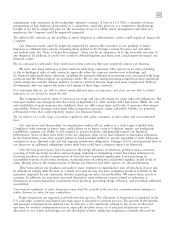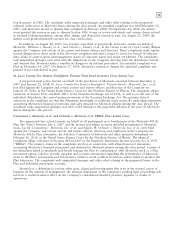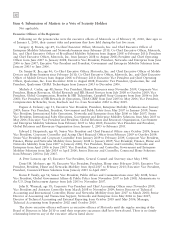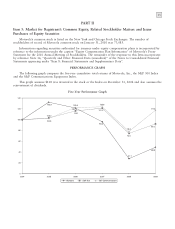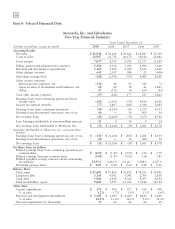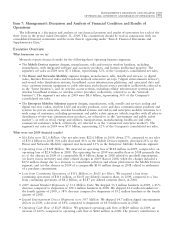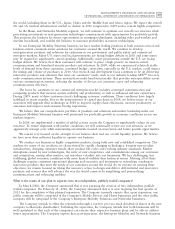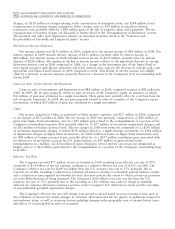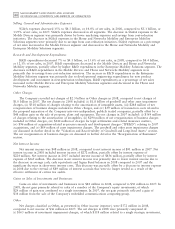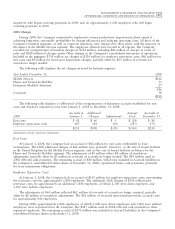Motorola 2009 Annual Report Download - page 45
Download and view the complete annual report
Please find page 45 of the 2009 Motorola annual report below. You can navigate through the pages in the report by either clicking on the pages listed below, or by using the keyword search tool below to find specific information within the annual report.
37
MANAGEMENT’S DISCUSSION AND ANALYSIS
OF FINANCIAL CONDITION AND RESULTS OF OPERATIONS
product portfolio. In 2009, the Company lost market share and was the fifth-largest worldwide supplier of
wireless handsets.
During the year, Mobile Devices reduced its cost structure by over $1.5 billion, including reductions in
research and development and selling, general and administrative costs. Reductions were the result of
eliminating product platforms, focusing on key markets and other efficiencies. In addition, operational
improvements were made in the supply chain, resulting in improved inventory management and reduced
levels of excess and obsolete inventory.
In the fourth quarter of 2009, the Mobile Devices business launched CLIQTM/DEXTTM with
MOTOBLURTM and DROID by Motorola/MILESTONETM, our first Android-based smartphones. These
phones represent the beginning of the transition of our portfolio to smartphones, the fastest growing
segment of the handset market. Our new products begin to address consumer demand for smartphones
with higher quality displays, broadband connectivity everywhere, over-the-air update capability, and
enhanced mobile experiences enabled by a multi-tasking, graphical operating system. Consumer reception
of our first smartphones was very strong, resulting in shipments of two million Android-based
smartphones in the fourth quarter of 2009.
From a financial perspective, the Mobile Devices segment significantly reduced its operating loss and cash
consumption in 2009 compared to 2008. This improvement was due primarily to the reduction in its cost
structure, improvement in operating and supply chain efficiencies, and implementation of its portfolio
transition, including the launch of new smartphones.
•In Our Home and Networks Mobility Business: The Home and Networks Mobility business was impacted
by a decline in the market for its home business. This was attributable largely to economic conditions in
the U.S. which negatively impacted consumer spending and housing. During 2009, the business remained
the world’s leading provider of digital entertainment devices and shipped its 100 millionth digital
entertainment device, improved its gross margin percentage, reduced operating expenses, maintained
operating profitability and generated cash.
While market conditions contributed to a decline in sales in the home business compared to 2008, the
longer term demand fundamentals for end-to-end video distribution systems, digital entertainment devices
and video network infrastructure remain intact. Continued prioritization of research and development
resulted in the business further enhancing its portfolio of advanced video products. This included the
launch of innovative digital entertainment devices, including multi-room DVR products. Portfolio
enhancements also included high-performance video servers and transcoding devices to enable operators to
provide more advanced viewing experiences and services. The home business also announced the
acquisition of BitBand, a leading provider of content management and delivery systems, specializing in
video-on-demand for IPTV.
As anticipated, the networks business experienced a decline in sales for all 2G and 3G technologies in
2009 compared to 2008. Motorola continued its investments and leadership in next-generation wireless
broadband technologies, including WiMAX and LTE. In WiMAX, we maintained a leading portfolio of
customers around the world and generated over $600 million in sales, making us the market leader. In
LTE, KDDI in Japan selected us for development and implementation of their LTE mobile broadband
network and we participated in several LTE trial activities with leading operators around the world.
•In Our Enterprise Mobility Solutions Business: In 2009, sales in the Enterprise Mobility Solutions business
were lower than in 2008. This was primarily due to a decline in demand in certain industries served,
resulting from adverse economic conditions. Enterprise Mobility Solutions maintained its leading global
market share position, reduced operating expenses, maintained a high level of operating profitability and
generated cash.
Despite the budget challenges facing many of the U.S. states, demand for our products and solutions by
customers in the government and public safety market in the U.S. was relatively consistent with 2008. By
leveraging our thought leadership, comprehensive portfolio and strong customer relationships, we
maintained market share in the U.S., our largest market. In the latter half of 2009, demand in the
commercial enterprise market, specifically in the retail vertical, for mobile computing and data capture
products began to improve. With the benefit of cost reductions implemented in the first half of 2009 and
improving demand trends, we were able to significantly improve the operating profitability of our
Enterprise Mobility Solutions business in the second half of the year.


